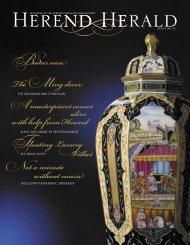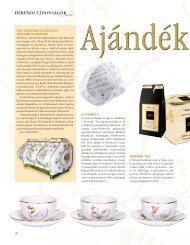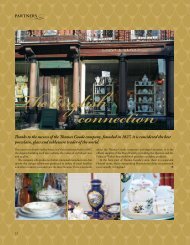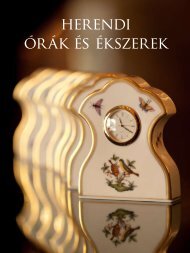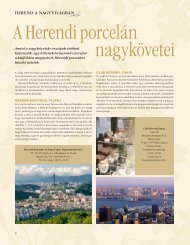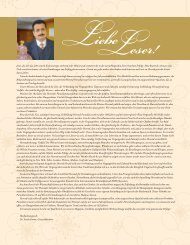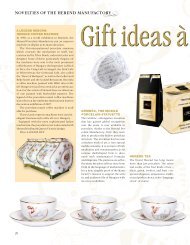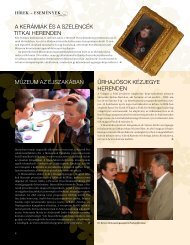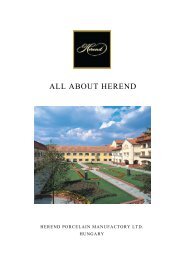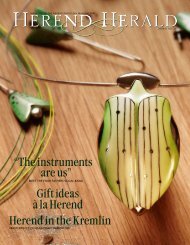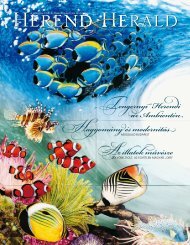LA PORCELAINE DE HEREND HEREND PORCELAIN
Genfi_32 q:Layout 1
Genfi_32 q:Layout 1
You also want an ePaper? Increase the reach of your titles
YUMPU automatically turns print PDFs into web optimized ePapers that Google loves.
Herend au XX e siècle:<br />
La tentation de la modernité<br />
Herend in the 20th century:<br />
The temptation of modernity<br />
De tous les descendants de Moritz Fischer qui joueront<br />
un rôle dans l’histoire de sa manufacture, c’est probablement<br />
son petit-fils Jenö Farkasházy Fischer qui lui ressemblera<br />
le plus par la richesse de sa personnalité et par<br />
l’ampleur de la vision qu’il développera pour l’entreprise.<br />
Passionné d’histoire de la céramique, Jenö avait visité les<br />
plus grands musées d’Europe et publié des études sur<br />
les créations du potier français Bernard Palissy au XVII e<br />
siècle, ou encore sur les œuvres plastiques de la<br />
famille florentine des Della Robbia à l’époque de la<br />
Renaissance. Même les réalités de l’industrie céramique<br />
moderne ne lui étaient pas inconnues, puisque au<br />
moment de se porter acquéreur de Herend, il occupait la<br />
fonction de directeur artistique à la manufacture de<br />
porcelaine de Ungvár (ou Oujgorod, aujourd’hui à l’extrême<br />
pointe ouest de l’Ukraine). Soucieux de rétablir<br />
Herend dans sa grandeur passée, il s’efforcera non sans<br />
mal de réorganiser l’entreprise.<br />
Son premier objectif sera de renouer avec la qualité, en<br />
réactualisant d’abord les modèles éprouvés de son<br />
grand-père. Parfaitement informé des nouvelles tendan -<br />
ces internationales, il introduisit par la suite un esprit<br />
novateur et expérimental à Herend, dans la mouvance<br />
des recherches menées un peu partout en Europe par les<br />
artistes et par les industries qui étaient en train de<br />
façonner la céramique de l’Art nouveau. Des émaux de<br />
haute température furent mis au point, dont l’aspect<br />
jaspé et apparemment aléatoire transfigurait la<br />
porcelaine tout en restituant l’esprit des antiques grès<br />
japonais (N° 47 et 48). Dans le registre de la porcelaine<br />
décorée, Farkasházy Fischer introduisit des motifs<br />
floraux peints dans la manière fluide et stylisée typique<br />
de la veine naturaliste de l’Art nouveau, ou des décors<br />
animaliers en relief rehaussés d’un subtil émail céladon<br />
lustré (N° 49). Dans la technique dite pâte-sur-pâte<br />
(N° 50), le motif est peint en relief, sur un fond coloré,<br />
au moyen de barbotine blanche (de la porcelaine à l’état<br />
semi liquide).<br />
Grâce à ses innovations – et grâce au répertoire traditi -<br />
onnel qu’il aura la sagesse de perpétuer – Jenö rempor -<br />
tera de nouveaux succès dans les grandes expositions<br />
internationales, tandis que la presse hongroise saluait la<br />
“renaissance de Herend”. Les nombreuses absences de<br />
Farkasházy Fischer, en raison de ses voyages à l’étranger<br />
et de ses activités mondaines ou politiques à Budapest,<br />
l’amenèrent cependant à négliger la gestion au quotidien.<br />
L’activité de l’entreprise ralentit considérablement<br />
dès 1917. Les effets de la guerre, puis les conséquences<br />
du Traité de Versailles, dramatiques pour la Hongrie,<br />
achevèrent de conduire la manufacture au bord d’un<br />
nouveau précipice. En 1923, Jenö accepta de transformer<br />
l’établissement en société par actions. Il garda la<br />
Out of all Moritz Fischer’s descendants who played a<br />
part in the history of his porcelain manufactory, his<br />
grandson, Jenö Farkasházy Fischer, probably resembled<br />
him the most with his richly-facetted personality and the<br />
breadth of vision he went on to develop for the company.<br />
Jenö, passionate about the history of ceramics, had<br />
visited the greatest museums of Europe and published<br />
studies on the creations of the French potter Bernard<br />
Palissy in the 17th century, and on the plastic works<br />
produced by the Della Robbia family in Florence during<br />
the Renaissance. Even the realities of the modern<br />
ceramics industry were not unknown to him, because<br />
at the time of acquiring Herend, he held the position<br />
of an artistic director at the Ungvár porcelain factory<br />
(Uzhgorod, now at the extreme western tip of Ukraine).<br />
Keen to restore Herend to its former greatness, he<br />
endeavoured, not without difficulty, to restructure the<br />
company.<br />
His first objective was to restore the quality of the<br />
production, initially by updating the models tried and<br />
tested by his grandfather. Perfectly au fait with the latest<br />
international trends, he went on to bring an innovative<br />
and experimental spirit into Herend, in line with the<br />
research being done almost everywhere in Europe by the<br />
artists and ceramic factories who were fashioning the<br />
ceramics of the Art Nouveau movement. High temperature<br />
enamels were developed, their apparently randomly<br />
marbled aspect transforming the porcelain whilst recreating<br />
the spirit of ancient Japanese stoneware (Nos. 47<br />
and 48). For the decorated porcelain ranges, Farkasházy<br />
Fischer introduced painted floral motifs in the fluid and<br />
stylised manner typical of the naturalist vein of Art Nouveau,<br />
and animal patterns in relief embellished with a<br />
subtle glossy celadon enamel (No. 49). In the technique<br />
known as pâte-sur-pâte (No. 50), the motif is painted in<br />
low relief on a coloured ground, using a white porcelain<br />
slip (porcelain in the semi-liquid state).<br />
Thanks to his innovations – and thanks to the traditional<br />
repertoire he was wise enough to continue – Jenö met<br />
with renewed success in the great international exhibitions,<br />
whilst the Hungarian press acclaimed the “Herend<br />
renaissance“. The numerous absences of Farkasházy<br />
Fischer however, due to his trips abroad and his political<br />
and social activities in Budapest, caused him to neglect<br />
the day-to-day management of the company. Business<br />
slowed considerably after 1917. The effects of the war,<br />
followed by the consequences of the Treaty of Versailles,<br />
which were dramatic for Hungary, combined to take the<br />
manufactory to the brink once more. In 1923, Jenö<br />
agreed to turn it into a joint stock company. He kept half<br />
the shares and limited his role to that of artistic director<br />
until his death in 1926.<br />
77<br />
Détail du N˚ 50:<br />
Vase, vers 1900<br />
Décor en relief: lézard et<br />
branche de prunier.<br />
Émail lustré céladon<br />
Detail of N˚ 50:<br />
Vase, ca. 1900<br />
Decorated in relief with a lizard<br />
and a plum branch.<br />
Lustred celadon glaze



